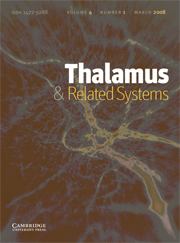Crossref Citations
This article has been cited by the following publications. This list is generated based on data provided by
Crossref.
Rosenblum, Michael
and
Pikovsky, Arkady
2004.
Delayed feedback control of collective synchrony: An approach to suppression of pathological brain rhythms.
Physical Review E,
Vol. 70,
Issue. 4,
Fogelson, Noa
Pogosyan, Alek
Kühn, Andrea A.
Kupsch, Andreas
Van Bruggen, Gerard
Speelman, Hans
Tijssen, Marina
Quartarone, Angelo
Insola, Angelo
Mazzone, Paolo
Di Lazzaro, Vincenzo
Limousin, Patricia
and
Brown, Peter
2005.
Reciprocal interactions between oscillatory activities of different frequencies in the subthalamic region of patients with Parkinson's disease.
European Journal of Neuroscience,
Vol. 22,
Issue. 1,
p.
257.
Garcia‐Larrea, Luis
Maarrawi, Joseph
Peyron, Roland
Costes, Nicolas
Mertens, Patrick
Magnin, Michel
and
Laurent, Bernard
2006.
On the relation between sensory deafferentation, pain and thalamic activity in Wallenberg's syndrome: A PET‐scan study before and after motor cortex stimulation.
European Journal of Pain,
Vol. 10,
Issue. 8,
p.
677.
Stern, Jair
Jeanmonod, Daniel
and
Sarnthein, Johannes
2006.
Persistent EEG overactivation in the cortical pain matrix of neurogenic pain patients.
NeuroImage,
Vol. 31,
Issue. 2,
p.
721.
Hughes, Stuart W.
and
Crunelli, Vincenzo
2007.
Just a phase they're going through: The complex interaction of intrinsic high-threshold bursting and gap junctions in the generation of thalamic α and θ rhythms.
International Journal of Psychophysiology,
Vol. 64,
Issue. 1,
p.
3.
Boord, P
Siddall, P J
Tran, Y
Herbert, D
Middleton, J
and
Craig, A
2008.
Electroencephalographic slowing and reduced reactivity in neuropathic pain following spinal cord injury.
Spinal Cord,
Vol. 46,
Issue. 2,
p.
118.
Henning Proske, J.
Jeanmonod, Daniel
and
Verschure, Paul F. M. J.
2011.
A computational model of thalamocortical dysrhythmia.
European Journal of Neuroscience,
Vol. 33,
Issue. 7,
p.
1281.
Michels, L.
Bucher, K.
Brem, S.
Halder, P.
Lüchinger, R.
Liechti, M.
Martin, E.
Jeanmonod, D.
Kröll, J.
and
Brandeis, D.
2011.
Does Greater Low Frequency EEG Activity in Normal Immaturity and in Children with Epilepsy Arise in the Same Neuronal Network?.
Brain Topography,
Vol. 24,
Issue. 1,
p.
78.
Miller, Kai J.
Abel, Taylor J.
Hebb, Adam O.
and
Ojemann, Jeffrey G.
2011.
Reorganization of large-scale physiology in hand motor cortex following hemispheric stroke.
Neurology,
Vol. 76,
Issue. 10,
p.
927.
Lüchinger, Rafael
Michels, Lars
Martin, Ernst
and
Brandeis, Daniel
2012.
Brain state regulation during normal development: Intrinsic activity fluctuations in simultaneous EEG–fMRI.
NeuroImage,
Vol. 60,
Issue. 2,
p.
1426.
Fuggetta, Giorgio
and
Noh, Nor Azila
2013.
A neurophysiological insight into the potential link between transcranial magnetic stimulation, thalamocortical dysrhythmia and neuropsychiatric disorders.
Experimental Neurology,
Vol. 245,
Issue. ,
p.
87.
Fuggetta, Giorgio
Bennett, Matthew A.
Duke, Philip A.
and
Young, Andrew M.J.
2014.
Quantitative electroencephalography as a biomarker for proneness toward developing psychosis.
Schizophrenia Research,
Vol. 153,
Issue. 1-3,
p.
68.
Ribary, Urs
Doesburg, Sam M.
and
Ward, Lawrence M.
2014.
Magnetoencephalography.
p.
429.
Kim, J. H.
Chien, J. H.
Liu, C. C.
and
Lenz, F. A.
2015.
Painful cutaneous laser stimuli induce event-related gamma-band activity in the lateral thalamus of humans.
Journal of Neurophysiology,
Vol. 113,
Issue. 5,
p.
1564.
van Wijngaarden, Joeri B. G.
Zucca, Riccardo
Finnigan, Simon
Verschure, Paul F. M. J.
and
Jbabdi, Saad
2016.
The Impact of Cortical Lesions on Thalamo-Cortical Network Dynamics after Acute Ischaemic Stroke: A Combined Experimental and Theoretical Study.
PLOS Computational Biology,
Vol. 12,
Issue. 8,
p.
e1005048.
Huang, Yongzhi
Geng, Xinyi
Li, Luming
Stein, John F.
Aziz, Tipu Z.
Green, Alexander L.
and
Wang, Shouyan
2016.
Measuring complex behaviors of local oscillatory networks in deep brain local field potentials.
Journal of Neuroscience Methods,
Vol. 264,
Issue. ,
p.
25.
Huishi Zhang, Clara
Sohrabpour, Abbas
Lu, Yunfeng
and
He, Bin
2016.
Spectral and spatial changes of brain rhythmic activity in response to the sustained thermal pain stimulation.
Human Brain Mapping,
Vol. 37,
Issue. 8,
p.
2976.
Bhattacharya, Basabdatta Sen
Bond, Thomas P.
O'Hare, Louise
Turner, Daniel
and
Durrant, Simon J.
2016.
Causal Role of Thalamic Interneurons in Brain State Transitions: A Study Using a Neural Mass Model Implementing Synaptic Kinetics.
Frontiers in Computational Neuroscience,
Vol. 10,
Issue. ,
Stankevich, Nataliya
and
Mosekilde, Erik
2017.
Coexistence between silent and bursting states in a biophysical Hodgkin-Huxley-type of model.
Chaos: An Interdisciplinary Journal of Nonlinear Science,
Vol. 27,
Issue. 12,
Yakovenko, I. A.
Cheremushkin, E. A.
and
Kozlov, M. K.
2017.
Coupling of the β Rhythm and Slow Electric Activity of the Cerebral Cortex during the Performance of Go/NoGo Tasks and the Identification of the Facial Expression.
Human Physiology,
Vol. 43,
Issue. 6,
p.
637.


